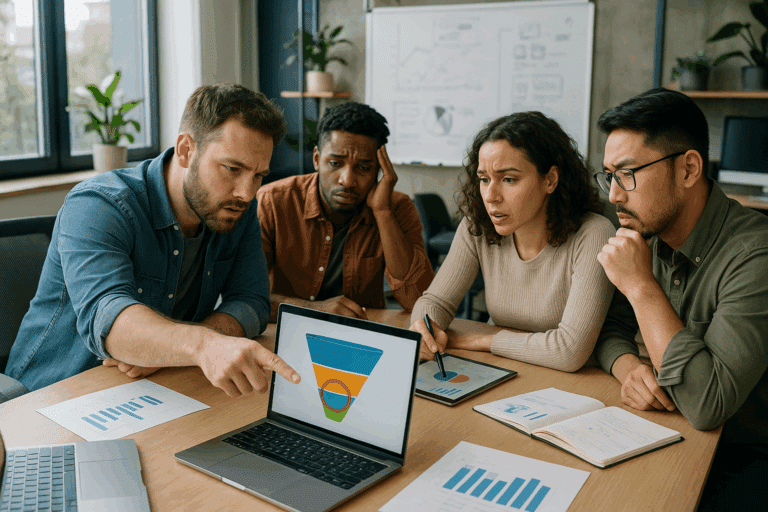🎯 This robust, data-driven method can unlock the gates of success for your B2B company by illuminating the customer journey, identifying growth opportunities, and ultimately, driving business performance.
Today’s digital age thrives on data. Data insights, when applied judiciously, can revolutionize your B2B company’s marketing strategies and contribute to a competitive edge in your industry. Yet, to harness these insights, one must first understand how to acquire, analyze, and apply them effectively. That’s where funnel analysis comes into play. 👀
💡Funnel Analysis: The Key to Success
Imagine funnel analysis as a magnifying glass for your customer’s journey. It observes every interaction, every engagement, every decision your customer makes while moving towards (or away from) your product or service. Essentially, it maps out the entire customer lifecycle, from the first point of contact to the final conversion, and beyond.
This intricate understanding of the customer journey allows B2B marketers to pinpoint precisely where they are losing potential clients and why. They can then proactively strategize to optimize each stage of the funnel, improving customer engagement, conversion rates, and ultimately, revenue.
🧩Unlocking Success with Funnel Analysis
Implementing funnel analysis effectively involves a systematic approach, encompassing customer data collection, meticulous analysis, and data-driven decision-making. It requires a deep understanding of the various stages in the customer journey, the ability to track and analyze key metrics at each stage, and the agility to adapt marketing strategies based on the insights gained.
The aim of this comprehensive guide is to empower B2B companies to master the art of funnel analysis. We’ll start by demystifying the concept, breaking it down into its core components, and explaining its pivotal role in B2B marketing. Next, we’ll delve into the practical aspects of implementing funnel analysis, discussing key metrics to track, common challenges faced, and effective strategies to overcome them. Finally, we’ll explore real-world examples of B2B companies who’ve successfully used funnel analysis to drive business growth and share insights on the future trends in this space.
Whether you’re a seasoned B2B marketer or a beginner, this guide aims to provide valuable insights and actionable steps to make your journey in mastering funnel analysis an enlightening and fruitful one.
So, are you ready to unlock success with funnel analysis? Let’s dive in. 🏊♂️
Understanding the Power of Funnel Analysis for B2B Companies
As we navigate through the digital age, the importance of a sound marketing strategy cannot be overstated. One tool that has gained prominence in the B2B arena is funnel analysis. Funnel analysis is a method of studying the step-by-step journey that a potential client takes from the first point of contact with your brand to the final conversion point. The goal is to identify potential roadblocks or leaks in the conversion process where potential clients might be dropping off.
This kind of analysis is crucial in helping businesses understand and optimize their sales and marketing processes. It allows them to identify bottlenecks in their conversion funnel, enabling them to focus their resources on the areas where they will have the most impact. With the right funnel analysis strategy, B2B companies can significantly improve their conversion rates and overall business performance.
But how do you master funnel analysis? What steps should you take to ensure you’re getting the most out of this valuable tool? In this article, we will delve deeper into these questions and provide actionable insights that you can use to enhance your B2B marketing strategy.
Decoding the Basics of Funnel Analysis
Before we dive into the intricacies of funnel analysis, let’s first understand what it entails. Essentially, a conversion funnel is a visual representation of the customer journey, from the first interaction with your brand to the final conversion. The funnel is broad at the top—representing the large pool of potential customers—and narrows down as you move towards conversion, representing the diminishing number of prospects as they go through the conversion process.
Funnel analysis, therefore, involves analyzing this journey to identify potential leaks—points where customers drop off before they convert. By studying these points, you can determine what might be causing customers to leave and then take steps to address these issues.
For B2B companies, funnel analysis can be a powerful tool. Unlike B2C companies, which often deal with individual consumers, B2B companies usually have a smaller pool of potential customers. As such, every conversion is crucial, and understanding where you’re losing prospects can make a significant difference to your bottom line.
Key Stages in a B2B Conversion Funnel
In a B2B context, a typical conversion funnel might look something like this:
- Awareness: The potential customer becomes aware of your brand or product. This could be through social media, a Google search, or a referral from another customer.
- Interest: The potential customer shows interest in your product or service. They might visit your website, read your blog posts, or download a free resource.
- Consideration: The potential customer starts considering your product or service as a potential solution to their problem. They might request a demo, ask for a quote, or contact your sales team for more information.
- Conversion: The potential customer decides to purchase your product or service.
At each stage of this funnel, there are potential drop-off points. For example, a potential customer might become aware of your brand but lose interest before they visit your website. Or they might consider your product but decide not to purchase it.
Funnel analysis involves identifying these drop-off points and understanding why they are happening. This is where the true power of funnel analysis lies—in its ability to provide insights that can help you improve your conversion process and boost your business performance.
Unlocking Success: Mastering Funnel Analysis
Now that we understand the basics of funnel analysis, let’s delve deeper into how you can master this technique to enhance your B2B marketing strategy.
Identifying Your Conversion Funnel
The first step to mastering funnel analysis is to clearly define your conversion funnel. This will vary depending on your business and the nature of your product or service. However, a typical B2B conversion funnel might include stages like awareness, interest, consideration, and conversion.
It’s important to note that your conversion funnel is not static—it will change over time as your business evolves and as you learn more about your customers. Regularly reviewing and updating your conversion funnel is therefore crucial to ensuring that your funnel analysis is accurate and useful.
Collecting and Analyzing Data
Once you’ve defined your conversion funnel, the next step is to collect data on how potential customers are moving through it. This can be done through various tools and techniques, such as Google Analytics, customer surveys, and user testing.
The data you collect should provide insights into where customers are dropping off in the conversion process. You should also be able to identify patterns—for example, are there specific stages where drop-offs are particularly high? Are there certain types of customers who are more likely to convert?
After collecting the data, the next step is to analyze it. This involves looking for patterns, trends, and insights that can help you understand why customers are dropping off at certain points in the conversion process. For example, if you notice that a large number of potential customers are leaving your website after viewing your product page, this could suggest that there’s something about your product or its presentation that’s not appealing to them.
Optimizing Your Conversion Funnel
Once you’ve identified the leaks in your conversion funnel, the next step is to address them. This could involve making changes to your website, tweaking your marketing messages, or improving your product. The goal is to create a smoother, more engaging customer journey that encourages more potential customers to convert.
Optimizing your conversion funnel is an ongoing process. It involves constantly monitoring your performance, testing different strategies, and refining your approach based on what you learn. However, with the right approach and the right tools, you can significantly improve your conversion rates and boost your business performance.
For a detailed look into funnel analysis and how it can benefit your B2B marketing strategy, watch this informative video by Jason Whaling, “The Perfect Sales Funnel Explained” on his YouTube channel, “Jason Whaling”.
Comparing Funnel Analysis Tools
There are numerous tools available to help you conduct funnel analysis. These range from free tools like Google Analytics to more complex and specialized software like Mixpanel and Kissmetrics. The best tool for you will depend on your specific needs and budget. Here’s a comparison of some popular funnel analysis tools:
| Tool | Features | Price |
|---|---|---|
| Google Analytics | Basic funnel analysis features, integration with other Google products | Free |
| Mixpanel | Detailed funnel analysis, user segmentation, A/B testing | Starts at $17/month |
| Kissmetrics | Funnel reports, cohort analysis, revenue tracking | Custom pricing |
Before choosing a tool, it’s important to consider what features you need, how much you’re willing to spend, and how the tool will fit into your existing workflow. Regardless of the tool you choose, the most important thing is to use it consistently and effectively to gain valuable insights into your conversion process.
Final Thoughts
Funnel analysis is a powerful tool that can help B2B companies improve their conversion rates and boost their business performance. However, mastering this technique requires a clear understanding of your conversion funnel, effective data collection and analysis, and a commitment to ongoing optimization.
With the right approach and the right tools, you can harness the power of funnel analysis to drive your B2B marketing strategy and unlock success for your business.
Remember:
As with any marketing strategy, the key to success is continuous learning and improvement. Stay updated with the latest trends in B2B marketing, continuously refine your strategies, and never stop learning. After all, the path to success is a journey, not a destination.

Conclusion
In conclusion, it is undeniable that we have covered some extensive grounds in this article, delving deep into the technical realms of IT and software engineering. With the rapid advancement of technology, it is paramount that we keep ourselves updated and informed about the latest trends and developments.
We started by understanding the basic concepts, laying the groundwork to delve deeper into the heart of IT and software engineering. In this journey, we explored the intricacies of programming languages, dived into the world of data structures and algorithms, and looked at the importance of system design and architecture. We underscored the need for rigorous testing and quality assurance, and also highlighted the value of effective project management in bringing a software product from conception to delivery.
As we move into an era of digital transformation, it is more critical than ever to master these key principles and practices. From cloud computing to cybersecurity, from machine learning to data science, the landscape of IT and software engineering is constantly evolving.
Moreover, we also discovered the role of soft skills in a technical environment. While technical proficiency is crucial, it is equally important to communicate effectively, work collaboratively and adapt to changing circumstances.
This article is just the tip of the iceberg in terms of the knowledge and skills required to excel in the field of IT and software engineering. It’s a vast ocean out there, and the more you explore, the more you learn.
So, take what you have learned from this article, and start applying it in your daily work. Remember, learning is a continuous process. So, never stop exploring, never stop learning, and never stop growing.
I encourage you to share your thoughts, insights, or questions in the comments section below. Share this article with your colleagues and friends who might find this useful. And most importantly, keep pushing your boundaries, keep challenging yourself, and keep learning.
As Albert Einstein once said, “Once you stop learning, you start dying”. So, keep that curiosity alive, keep learning, and keep growing.
For further reading, you can explore these resources:
1. IBM Cloud Learning Centre – A great resource for learning about cloud computing and its applications.
2. Coursera Machine Learning Course – A comprehensive course on machine learning by Stanford University.
3. W3Schools – An excellent resource for learning different programming languages, including HTML, CSS, JavaScript, Python, and many more.
Until our next deep dive into the world of IT and software engineering, happy learning and stay curious. 😊
References:
1. IBM Cloud Learning Centre
2. Coursera Machine Learning Course
3. W3Schools



